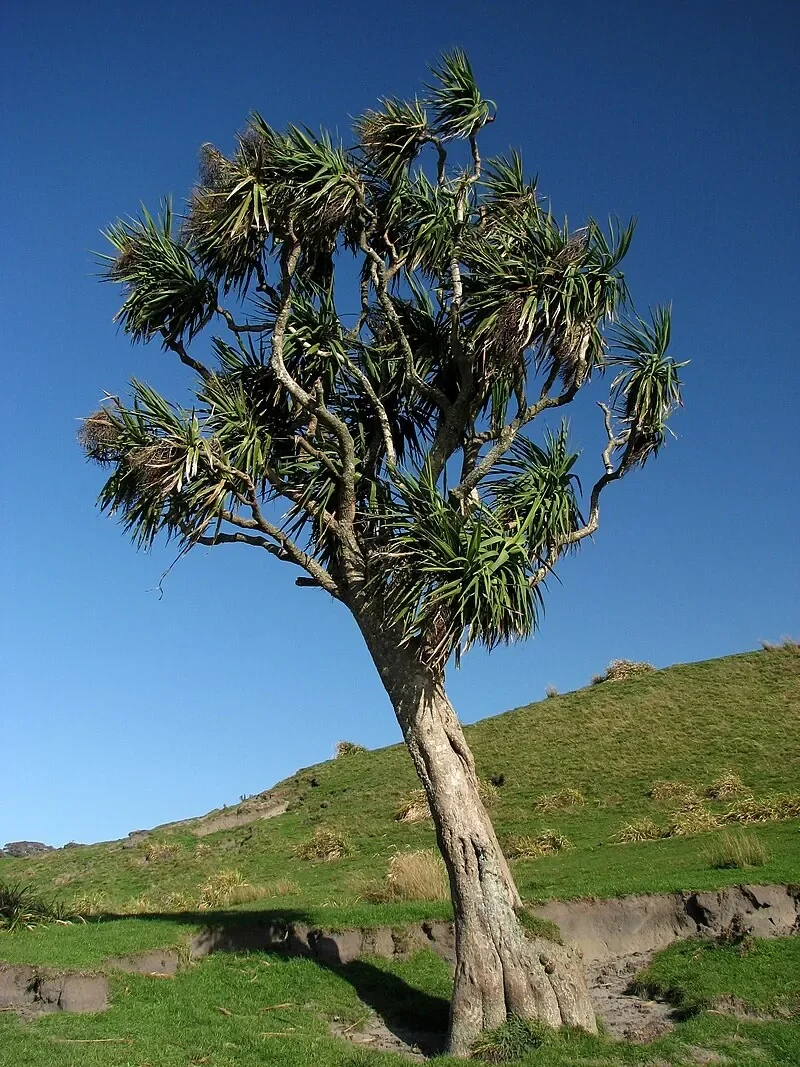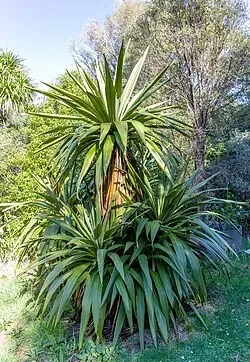
Cabbage Tree
Cordyline australis
Introduction
Introduction Overview
Cordyline australis , also known as the cabbage tree or tā kōuka, is a distinctive and iconic New Zealand plant with long, sword-shaped leaves and tall flowering spikes. It is valued for its resilience and cultural significance. You can find more information about various native plants on our homepage , including Cordyline indivisa . Learn more about native trees.

Plant Description
Botanical Features
Cordyline australis , commonly known as the Cabbage Tree or Tā kōuka, is a distinctive and iconic monocot tree native to New Zealand. It can grow up to 20 meters tall in its native habitat, typically featuring a stout trunk that can reach 1.5 to 2 meters in diameter. Young plants often appear as a fountain of grass-like leaves without a trunk. The tree's sword-shaped leaves are gray-green, up to 3 feet long, and 2-3 inches wide, clustered at the tips of the branches. It produces impressive panicles of small, fragrant white flowers in late spring to early summer, followed by white or cream berries. The plant typically divides into forks after its first flowering, which usually occurs between 6 to 10 years of age. It is incredibly adaptable, tolerating a wide range of soils and conditions, from boggy to dry, and is highly tolerant of frost and salt spray.
Quick Facts
| Scientific Name | Cordyline Australis |
|---|---|
| Height | Up to 20 m (in the wild); 8-12 m in gardens |
| Spread | 3-6 m (broad, multi-branched crown) |
| Water Needs | Low to moderate; drought-tolerant once established |
| Light | Full sun (best form and flowering) |
| Frost Tolerance | High (tolerates moderate to severe frost) |
| Salt Tolerance | High (excellent coastal/salt wind tolerance) |
| Growth Rate | Fast (especially in open, sunny sites) |
| Lifespan | Very long -lived (hundreds of years possible) |
The Cabbage Tree is incredibly adaptable and grows throughout New Zealand from coastal areas to lower mountain areas up to about 1000 m. It is tolerant of a wide range of conditions, from hot and dry to cold and wet.
Regional Suitability
| City | Climate Suitability |
|---|---|
| Whangārei | Ideal |
| Auckland | Ideal |
| Hamilton | Ideal |
| Tauranga | Ideal |
| Rotorua | Ideal |
| Gisborne | Ideal |
| New Plymouth | Ideal |
| Napier | Ideal |
| Whanganui | Ideal |
| Palmerston North | Ideal |
| Wellington | Ideal |
| Nelson | Ideal |
| Christchurch | Ideal |
| Dunedin | Ideal |
| Invercargill | Ideal |
Natural Habitat
Natural Habitat Overview
Cordyline is naturally found in specific habitats throughout New Zealand. Understanding its natural environment helps in providing appropriate growing conditions in cultivation.
Plant Conservation
Cordyline australis , also known as the cabbage tree, has a current conservation status of "Not Threatened" as of 2023. The IUCN Red List of Threatened Plants has not yet assessed this taxon.
While it is considered common and widespread in its native New Zealand, populations have been affected by a mysterious illness called "Sudden Decline" and a phenomenon known as "Rural Decline," which impacts older trees in grazed areas. Despite these challenges, it remains a common and thriving species in many modified ecosystems in coastal and lowland New Zealand. In some parts of Australia, it is regarded as an emerging environmental weed.
Soil Requirements
Cabbage Tree is remarkably adaptable to different soil conditions:
- Tolerates a wide range of soil types from clay to sandy
- Prefers well -draining soils but can handle occasional waterlogging
- Thrives in moderately fertile soils but will grow in poor soils too
- Can tolerate slightly acidic to slightly alkaline pH
- Handles coastal conditions including salt spray
Light Requirements
Cabbage Trees are sun-lovers that perform best with:
- Full sun for optimal growth and form
- Can tolerate partial shade but may develop a leggier form
- At least 6 hours of direct sunlight daily is ideal
- Northern or eastern exposures work well in garden settings
Water Requirements
Once established , Cabbage Trees are drought-tolerant:
- Moderate watering during establishment (first 1-2 years)
- Drought-tolerant once established
- Can handle periods of soil saturation
- Reduce watering in winter when growth slows
- Signs of overwatering include yellowing leaves and crown rot
Planting Guide
Planting Guide Overview
- Choose a sunny or partially shaded site with well-drained soil.
- Dig a hole twice the width of the root ball.
- Plant at the same depth as in the pot.
- Backfill and firm gently.
- Water well after planting.
- Mulch to retain moisture and suppress weeds.
Ecological Role
Wildlife Interactions
Cordyline plays an important ecological role in New Zealand's native ecosystems alongside other significant native trees such as coastal kowhai. It provides habitat and food for native wildlife and contributes to ecosystem health and biodiversity.
Traditional Uses
- The leaves of Cordyline australis were used by Māori for weaving, rope, and textiles.
- The roots were cooked and eaten as a carbohydrate source.
- Used in traditional medicine for various ailments.
Modern Uses
- Popular as a striking specimen tree in gardens and parks.
- Used for shelterbelts and erosion control.
- Valued for its architectural form and resilience.
Landscaping Uses
Landscaping Uses Overview
Cordyline is highly valued in landscaping for its aesthetic appeal and practical benefits. It can be used in various garden styles and landscape applications.
Spring
- New growth begins
- Apply a balanced fertilizer if desired (though not usually necessary)
- A good time to plant new specimens or divide offsets
- Monitor for new pest activity
Summer
- Flowering typically occurs in early summer
- Water young trees during extended dry periods
- Look out for infestations of cabbage tree moth caterpillars
- No pruning needed during the growing season
Autumn
- White or cream berries develop and ripen
- Natural leaf shedding occurs (normal part of growth cycle)
- Good time for planting new specimens
- Clean up fallen leaves if desired
Winter
- Generally dormant with minimal growth
- No special winter protection needed in most of New Zealand
- Suitable time for pruning if needed
- Fallen leaves can be left as mulch or removed for tidiness
Cabbage Trees generally need minimal pruning:
- Remove dead , damaged or diseased branches at any time
- To create a multi-trunked specimen, cut the main stem to encourage branching
- Fallen leaves can be removed for a tidier appearance, or left for a more natural look
- If necessary , lower branches can be removed to create clearance underneath
- Major pruning is best done in late winter to early spring
Always use clean, sharp tools for pruning to minimize the risk of disease. The cut stem often branches, creating a more bushy appearance.
How to Grow Cabbage Tree
The Cabbage Tree is an iconic and highly adaptable native plant, renowned for its resilience and architectural form. It is a relatively easy plant to grow, thriving in a wide range of conditions, from coastal areas to cooler inland regions. Its distinctive silhouette and fragrant flowers make it a popular choice for gardens, parks, and restoration projects. While generally low-maintenance, understanding its propagation methods can help in expanding its presence and ensuring its continued success.
From Seed
Cabbage Trees can be easily grown from seed, although it can take several years for seedlings to develop into sizeable plants. Collect fresh seeds from the white or cream berries in autumn. Clean the seeds thoroughly to remove any pulp and sow them in a well-draining seed-raising mix. Lightly cover the seeds with a thin layer of mix. Maintain consistent moisture and a temperature of around 15-20°C for optimal germination, which typically occurs within 4-6 weeks. Once seedlings are large enough to handle, prick them out and pot them into individual containers. Protect young plants from frost and gradually acclimate them to outdoor conditions before planting into their final position.
From Cuttings
Cabbage Trees can also be readily propagated from stem cuttings. This method is particularly useful for replicating specific forms or for quickly producing larger plants. Take stem sections, about 6-12 inches long, from healthy, mature stems in late spring to early summer. Ensure each cutting has at least one node. Remove any leaves from the lower half of the cutting and, if desired, dip the cut end in a rooting hormone. Insert the cuttings into a well-draining potting mix, ensuring good contact with the medium. Keep the cuttings moist and in a warm, sheltered location with indirect light. Rooting can occur within a few weeks, and the new plants can be potted on once established.
From Suckers
Established Cabbage Trees often produce suckers or offsets from the base of the main trunk. These can be easily detached and grown into new plants. Carefully separate the suckers from the parent plant using a sharp knife or spade, ensuring each sucker has some roots attached. Plant the suckers directly into a well-draining potting mix or into their final garden position. Water thoroughly after planting and keep consistently moist until established. This method is quick and provides a good way to multiply existing plants.
Pests and Diseases
Common Pests
Cordyline is generally resistant to most pests due to its native adaptations. However, it may occasionally be affected by common garden pests such as aphids or scale insects.
Disease Prevention
To prevent diseases, ensure good air circulation around Cordyline and avoid overwatering. Remove any diseased plant material promptly to prevent spread.
Cultural Significance
Cordyline australis , commonly known as the cabbage tree or tī kōuka, holds profound cultural significance, particularly within Māori culture in New Zealand.
Traditional Uses:
- Food Source: The soft inner core of young plants and the sugar-rich rhizomes (roots) were a vital food source, especially in the South Island where they were steamed in umu or hāngī and known as kauru.
- Fibre and Weaving: The long, narrow leaves were extensively used for practical purposes such as weaving, making rain capes, sandals, ropes, baskets, and thatching. The fibre derived from Cordyline australis is notably stronger than that from New Zealand flax.
- Medicine: The roots of the plant were incorporated into traditional Māori medicine.
- Cooking: Its water-resistant leaves were also utilized to create traditional cooking baskets.
Folklore and Recreation:
Beyond practical applications, Cordyline australis features in Māori folklore, with stories related to the tī leaves' use for food and medicine. The plant's strong leaves and fibre were also fashioned into ropes for mā rere (swings), providing recreation for Māori children. It stands as a symbol of New Zealand's natural heritage and resilience within the landscape.
Early European Uses:
Early European settlers also found uses for the plant, including distilling a liquor from its rhizomes in the 1850s and using its leaves for woven hats and children's toboggans. The common name "cabbage tree" was adopted by early European sailors and travelers due to its palm-like appearance, rather than its culinary use as a cabbage.
Bonus Tip
Expert Growing Advice
Don't be afraid to give your Cabbage Tree a dramatic haircut! While it may seem drastic, Cordyline australis is incredibly resilient and responds well to pruning. If your tree becomes too tall for its location or you want to encourage a bushier, multi-trunked form, you can cut the main stem at any height. New shoots will emerge from just below the cut, creating a fuller appearance. The best time to do this is in spring when the plant is actively growing. This is a great way to manage the size of your Cabbage Tree and create a unique architectural feature in your garden.







